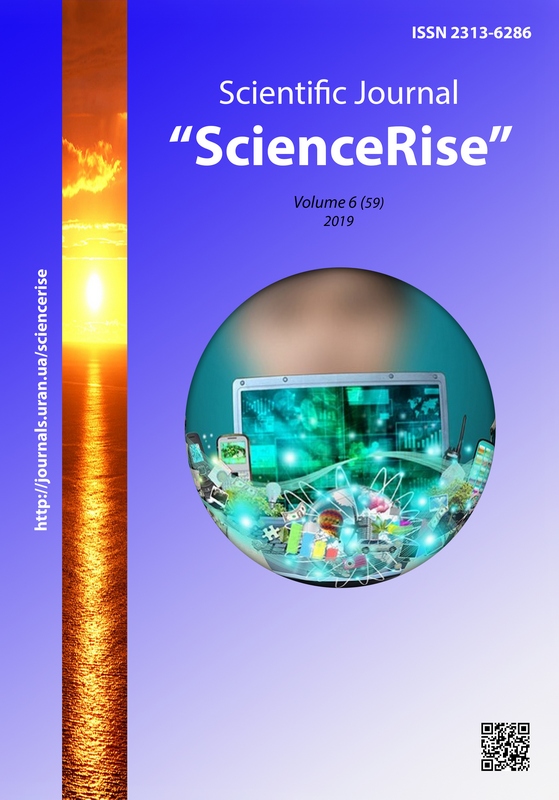Методика розробки інформаційно-технічного способу локалізації надзвичайних ситуацій медико-біологічного характеру регіонального рівня поширення небезпеки
DOI:
https://doi.org/10.15587/2313-8416.2019.173355Ключові слова:
надзвичайна ситуація, небезпеки медико-біологічного характеру, локалізація, інформаційно-технічний спосібАнотація
У роботі проаналізовано сучасний стан небезпеки виникнення та поширення надзвичайних ситуацій медико-біологічного характеру, які викликані інфекційними захворюваннями людей, на території України. Обгрунтовано припущення впливу на процес поширення надзвичайних ситуацій факторів природного характеру: вологості та температури навколишнього середовища, динаміки переміщення повітряних мас. Запропоновано підхід до моделювання процесів попередження та локалізації надзвичайних ситуацій медико-біологічного характеру. На базі останього визначено структуру інформаційно-технічного способу локалізації надзвичайних ситуацій медико-біологічного характеру
Посилання
Shevchenko, R. I. (2018) Formuvannia matematychnoi modeli orhanizatsiino-tekhnichnoho metodu skorochennia nehatyvnykh naslidkiv nadzvychainykh sytuatsii medyko-biolohichnoho kharakteru rehionalnoho rivnia poshyrennia nebezpeky. Komunalne hospodarstvo mist. Seriia: Tekhnichni nauky ta arkhitektura, 142, 124–131.
Prokopenko, O. V., Shevchenko, R. I. (2018). Informatsiina pidtrymka zakhodiv z lokalizatsii nadzvychainykh sytuatsii medyko-biolohichnoho kharakteru. Suchasni napriamy rozvytku informatsiino-komunikatsiinykh tekhnolohii ta zasobiv upravlinnia. Baku-Kharkiv-Zhilina, 84.
Analitychnyi ohliad stanu tekhnohennoi ta pryrodnoi bezpeky v Ukraini za 2018 rik. Available at: https://www.dsns.gov.ua/ua/Analitichniy-oglyad-stanu-tehnogennoyi-ta-prirodnoyi-bezpeki-v--Ukrayini-za-2015-rik.html
Shevchenko, R. I. (2018). Formuvannia alhorytmu ta protsedur orhanizatsiino-tekhnichnoho metodu skorochennia nehatyvnykh naslidkiv nadzvychainykh sytuatsii medyko-biolohichnoho kharakteru rehionalnoho rivnia poshyrennia nebezpeky. Problemy nadzvychainykh sytuatsii, 27, 175–186.
Zhuang, Y. (2017). Constructing Effective Mechanism of Reflection on Major Accidents Zhang Supei. China Safety Science Journal, 11. Available at: http://oversea.cnki.net/kns55/oldNavi/n_Catalog.aspx?NaviID=48&Flg=local&YearID
Qian, Y., Juncheng, J., Hanhua, Y. (2012). Research on the Emergency Response System of Major Dangerous Chemical Accident on Highway based on the GIS. Procedia Engineering, 45, 716–721. doi: http://doi.org/10.1016/j.proeng.2012.08.229
Xianfu, F., Zaoping, F., Yansong, H. (2012). Analysis on Chemical Industry Park Emergency Drill Escape Paths based on WebGIS. Procedia Engineering, 45, 721–726. doi: http://doi.org/10.1016/j.proeng.2012.08.230
Management in the Case of Strong Earthquakes. Information Technology180 for Disaster Management (2001). A collection of selected international papers. Asian Disaster Reduction Center. Kobe, 94–105.
Li, Q., Ruan, W., Shao, W., Huang, G. (2012). Information disclosure in an environmental emergency. Disaster Prevention and Management: An International Journal, 26 (2), 134–147. doi: http://doi.org/10.1108/dpm-06-2016-0125
Ouyang, Z., Wei, J., Xiao, Y., Wang, F. (2017). Media attention and corporate disaster relief: evidence from China. Disaster Prevention and Management: An International Journal, 26 (1), 2–12. doi: http://doi.org/10.1108/dpm-10-2015-0247
Martin, N., Rice, J. (2012). Emergency communications and warning systems: Determining critical capacities in the Australian context. Disaster Prevention and Management: An International Journal, 21 (5), 529–540. doi: http://doi.org/10.1108/09653561211278671
Yeo, J., Comfort, L. K. (2017). An expected event, but unprecedented damage: Structure and gaps of large-scale response coordination of the 2011 Thailand floods. Disaster Prevention and Management: An International Journal, 26 (4), 458–470. doi: http://doi.org/10.1108/dpm-02-2017-0048
Guo, X., Kapucu, N. (2015). Network performance assessment for collaborative disaster response. Disaster Prevention and Management: An International Journal, 24 (2), 201–210. doi: http://doi.org/10.1108/dpm-10-2014-0209
Azarenko, E. V., Goncharenko, Iu. Iu., Diviziniuk, M. M., Kovach, V. E. (2015). Chrezvychainye situatsii, obuslovlennye informatsionnymi potokami. Pravove, normativne ta metrologіchne zabezpechennia sistemi zakhistu іnformatsіi v Ukrainі, 2, 21–25.
Strilets, V. M., Borodych, P. Yu., Rosokha, S. V. (2012). Zakonomirnosti diialnosti riatuvalnykiv pry provedenni avariino-riatuvalnykh robit na stantsiiakh metropolitenu. Kharkiv: KP «Miska drukarnia», 112.
Babaryka, I. H., Yeremenko, S. A., Kryvulkin, I. M., Lievtierov, O. A., Shevchenko, R. I. (2018). Rozvytok innovatsiinykh metodiv skorochennia naslidkiv nadzvychainykh sytuatsii pryrodnoho kharakteru. Problemy nadzvychainykh sytuatsii, 28, 27–38.
Romaniukha, A. A. (2012). Matematicheskie modeli v immunologii i epidemiologii infektsionnykh zabolevanii. Moscow: BINOM. Laboratoriia znanii, 293.
##submission.downloads##
Опубліковано
Номер
Розділ
Ліцензія
Авторське право (c) 2019 Olga Prokopenko, Roman Shevchenko

Ця робота ліцензується відповідно до Creative Commons Attribution 4.0 International License.
Наше видання використовує положення про авторські права Creative Commons CC BY для журналів відкритого доступу.
Автори, які публікуються у цьому журналі, погоджуються з наступними умовами:
1. Автори залишають за собою право на авторство своєї роботи та передають журналу право першої публікації цієї роботи на умовах ліцензії Creative Commons CC BY, котра дозволяє іншим особам вільно розповсюджувати опубліковану роботу з обов'язковим посиланням на авторів оригінальної роботи та першу публікацію роботи у цьому журналі.
2. Автори мають право укладати самостійні додаткові угоди щодо неексклюзивного розповсюдження роботи у тому вигляді, в якому вона була опублікована цим журналом (наприклад, розміщувати роботу в електронному сховищі установи або публікувати у складі монографії), за умови збереження посилання на першу публікацію роботи у цьому журналі.

